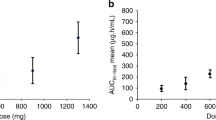Summary
Background Lurbinectedin administered as a 1-h intravenous infusion every 3 weeks induces neutropenia, with the nadir usually occurring during the second week. This phase I study evaluated an alternative lurbinectedin dosing schedule consisting of a 1-h infusion on days 1 and 8 every 3 weeks. Patients and methods Twenty-one patients with advanced cancer received lurbinectedin using a standard cohort dose escalation design. Results Three dose levels of 3, 4, and 5 mg of lurbinectedin were explored. The recommended phase II dose was 5 mg, with 3 of 13 patients having dose-limiting toxicity (DLT), although grade 4 neutropenia occurred in 50% of patients. Other frequent toxicities were mild to moderate nausea and vomiting, fatigue, decreased appetite, stomatitis and asymptomatic creatinine and transaminase increases. No objective responses occurred, but prolonged stable disease was observed in 7 patients, including 3 with soft tissue sarcoma. Conclusion The recommended phase II dose of lurbinectedin is 5 mg, administered as a 1-h infusion on days 1 and 8 every 3 weeks. These data support further testing of this dose and schedule, particularly in soft tissue sarcoma.

Similar content being viewed by others
References
Leal JF, Martinez-Diez M, Garcia-Hernandez V, Moneo V, Domingo A, Bueren-Calabuig JA, Negri A, Gago F, Guillen-Navarro MJ, Aviles P, Cuevas C, Garcia-Fernandez LF, Galmarini CM (2010) PM01183, a new DNA minor groove covalent binder with potent in vitro and in vivo anti-tumour activity. Br J Pharmacol 161:1099–1110
Santamaria Nunez G, Robles CM, Giraudon C, Martinez-Leal JF, Compe E, Coin F, Aviles P, Galmarini CM, Egly JM (2016) Lurbinectedin specifically triggers the degradation of phosphorylated RNA polymerase II and the formation of DNA breaks in cancer cells. Mol Cancer Ther 15:1–14. doi:10.1158/1535-7163.MCT-16-0172
Santamaria G, Avila S, Moneo V, Cuevas C, García-Fernández FC, Galmarini CM (2015) Synergistic combination of lurbinectedin and PARP inhibitors in breast cancer tumor cell lines 106th Annual Meeting of the American Association for Cancer Research:Abstract 2520
Allavena P, Belgiovine C, Liguori M, Bello E, Frapolli R, Galmarini CM, D'Incalci M (2016) Lurbinectedin reduces tumor-associated macrophages and the production of inflammatory cytokines, chemokines, and angiogenic factors in preclinical models. 107th Annual Meeting of the American Association for Cancer Research:Abstract 1284
Elez ME, Tabernero J, Geary D, Macarulla T, Kang SP, Kahatt C, Pita AS, Teruel CF, Siguero M, Cullell-Young M, Szyldergemajn S, Ratain MJ (2014) First-in-human phase I study of lurbinectedin (PM01183) in patients with advanced solid tumors. Clin Cancer Res 20:2205–2214. doi:10.1158/1078-0432.CCR-13-1880
Pernice T, Bishop AG, Guillen MJ, Cuevas C, Aviles P (2016) Development of a liquid chromatography/tandem mass spectrometry assay for the quantification of PM01183 (lurbinectedin), a novel antineoplastic agent, in mouse, rat, dog, Cynomolgus monkey and mini-pig plasma. J Pharm Biomed Anal 123:37–41. doi:10.1016/j.jpba.2016.01.043
National Cancer Institute (2006) Common Terminology Criteria for Adverse Events v3.0 (CTCAE). http://www.eortc.be/services/doc/ctc/ctcaev3.pdf
Therasse P, Arbuck SG, Eisenhauer EA, Wanders J, Kaplan RS, Rubinstein L, Verweij J, Van Glabbeke M, van Oosterom AT, Christian MC, Gwyther SG (2000) New guidelines to evaluate the response to treatment in solid tumors. European Organization for Research and Treatment of cancer, National Cancer Institute of the United States, National Cancer Institute of Canada. J Natl Cancer Inst 92:205–216
Acknowledgements
The authors wish to thank the patients, their families, and the clinical research teams for their time and trust, and for enabling this clinical trial and associated research.
Author information
Authors and Affiliations
Corresponding author
Ethics declarations
Conflicts of interest
SS, CFM, ASM, JLI and MC are Pharma Mar S.A. employees.
Ethical approval
All procedures performed in studies involving human participants were in accordance with the ethical standards of the institutional and/or national research committee and with the 1964 Helsinki declaration and its later amendments or comparable ethical standards.
Informed consent
Written informed consent was obtained from all individual patients included in this study.
Funding
This work was supported by Pharma Mar, S.A.
Electronic supplementary material
ESM 1
(DOCX 11 kb)
Rights and permissions
About this article
Cite this article
Jimeno, A., Sharma, M.R., Szyldergemajn, S. et al. Phase I study of lurbinectedin, a synthetic tetrahydroisoquinoline that inhibits activated transcription, induces DNA single- and double-strand breaks, on a weekly × 2 every-3-week schedule. Invest New Drugs 35, 471–477 (2017). https://doi.org/10.1007/s10637-017-0427-2
Received:
Accepted:
Published:
Issue Date:
DOI: https://doi.org/10.1007/s10637-017-0427-2




